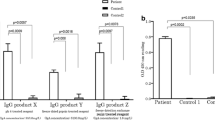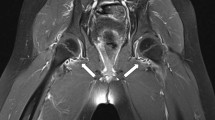Summary
A 50-year-old woman with primary biliary cirrhosis developed immune hemolytic anemia and renal failure while receiving rifampicin for the treatment of refractory pruritus. Serological studies revealed the presence of rifampicin-dependent antibodies of the IgM class that, when tested against a wide panel of erythrocytes, had anti-I specificity. Subsequently, rifampicin was withdrawn and prednisone treatment instituted, this resulting in a rapid resolution of the hemolysis, whereas hemodialysis was required for recovery of the renal function. A role is suggested for the anti-I specificity of the antibodies in the development of renal failure associated with rifampicin therapy.
Similar content being viewed by others
References
Advani H, Zamor J, Judd WJ, Johnson CL, Marsh WL (1982) Inactivation of Kell blood group antigens by 2-aminoethyllisothiouronium. Br J Haematol 51: 107–115
Bachs L, Parés A, Elena M, Piera C, Rodés J (1989) Comparison of rifampicin with phenobarbitone for treatment of pruritus in biliary cirrhosis. Lancet 1: 574–576
Durán-Suárez JR, Martín-Vega C, Argelagués E, Massuet L, Ribera A, Triginer J (1981) Red cell I antigen as immune complex receptor in drug-induced hemolytic anemias. Vox Sang 41: 313–315
Habibi B (1985) Drug-induced red blood cell autoantibodies co-developed with drug-specific antibodies causing haemolytic anaemias. Br J Haematol 61: 139–143
Habibi B, Bretagne Y (1983) Blood group antigens may be the receptors for specific drug-antibody complexes reacting with red blood cells. C R Acad Sci [III] 256: 693–696
Habibi B, Basty R, Chodez S, Prunat A (1985) Thiopental-related immune hemolytic anemia and renal failure: specific involvement of the red-cell antigen I. N Eng J Med 312: 353–355
Jordan JV, Smith ME, Reid DM, Jones CE, Kautz CA, Shulman NR (1985) A tolmetin-dependent antibody causing severe intravascular hemolysis binds to erythrocyte band 3 and requires only the F(ab')2 domain to react. Blood 66: 104 a
Kucers A, MacBennett H, Kemp RJ (1987) The use of antibiotics. William Heinemann Medical Book, London, pp 914–970
Lenhard V, Seelig HP, Geisen HP, Roelke D (1978) Identification of I/i, Pr1–3 and Gd antigens in the human kidney: posible relevance to hyperacute graft rejection induced by cold agglutinins. Clin Exp Immunol 33: 276–282
Martínez J, Barbolla L, Frieyro E, et al. (1977) Immune haemolytic anaemia and renal failure induced by streptomycin. Br J Haematol 35: 561–571
Mauri JM, Fort J, Camps J, et al. (1982) Antirifampicin antibodies in acute rifampicin-associated renal failure. Nephron 31: 177–179
Nessi R, Bonoldi GL, Redaelli B, Di Filippo G (1976) Acute renal failure after rifampicin: a case report and survey of the literature. Nephron 16: 148–159
Petz LD, Branch DR (1985) Drug-induced immune hemolytic anemia. In: Chaplin H jr (ed) Immune hemolytic anemias. Churchill Livingstone, New York, pp 47–94
Petz LD, Garraty G (1980) Acquired immune hemolytic anemias. Churchill Livingstone, New York
Pirofsky B, Rosner ER (1974) DTT test: a new method to differentiate IgM and IgG erythrocyte antibodies. Vox Sang 27: 480–488
Salama A, Mueller-Eckhart C (1987) On the mechanism of sensitization and attachment of antibodies to RBC in druginduced hemolytic anemia. Blood 69: 1006–1010
Tahan SR, Diamond JR, Blank JM, Horan RF (1985) Acute hemolysis and renal failure with rifampicin-dependent antibodies after discontinuous administration. Transfusion 25: 124–127
Wilson CB (1979) Immunologic mechanisms of renal disease. Churchill Livingstone, New York
Zetterman RK, Woltjen JA (1980) Suppressor cell activity in primary biliary cirrhosis. Dig Dis Sci 25: 104–107
Author information
Authors and Affiliations
Additional information
This work was partially supported by grant FISS 90/0486 from theMinisterio de Sanidad y Consumo of Spain
Rights and permissions
About this article
Cite this article
Pereira, A., Sanz, C., Cervantes, F. et al. Immune hemolytic anemia and renal failure associated with rifampicin-dependent antibodies with anti-I specificity. Ann Hematol 63, 56–58 (1991). https://doi.org/10.1007/BF01714964
Received:
Accepted:
Issue Date:
DOI: https://doi.org/10.1007/BF01714964




